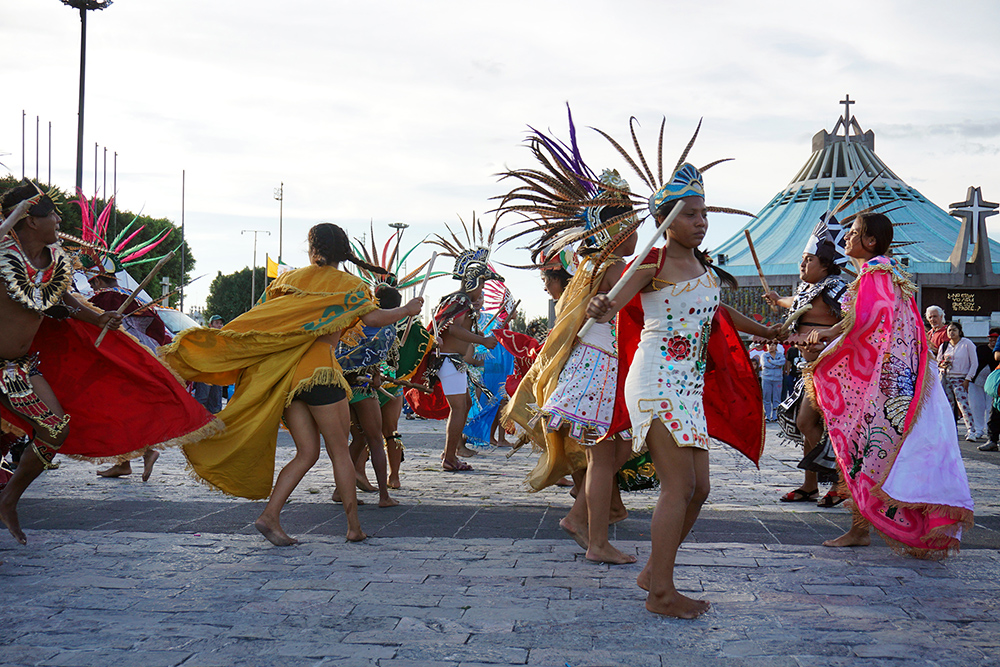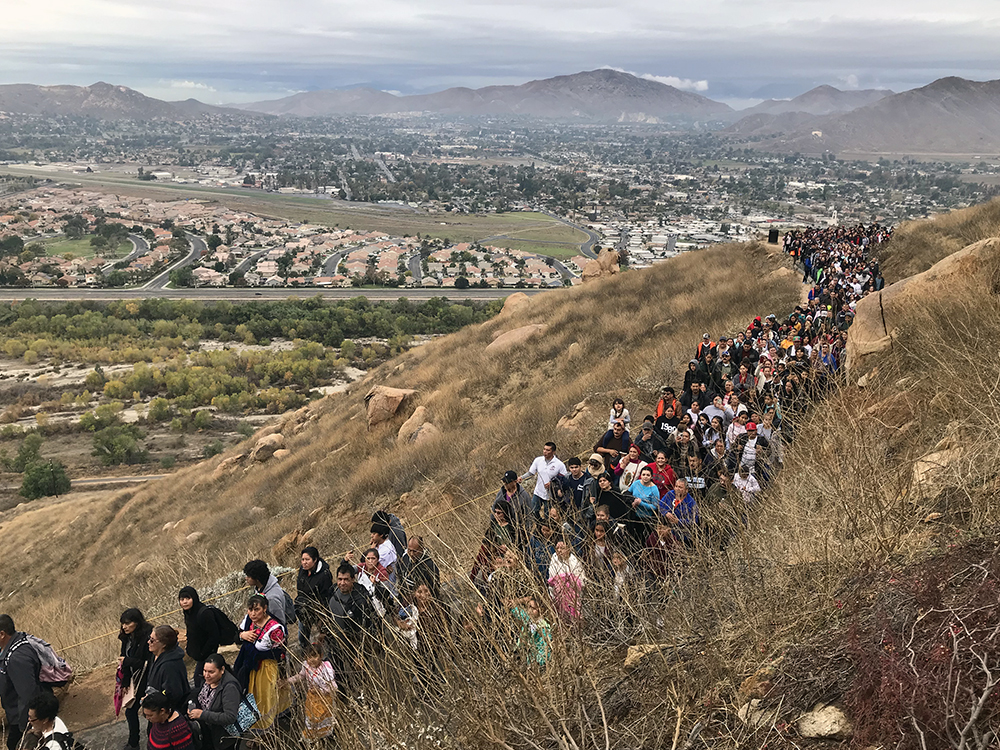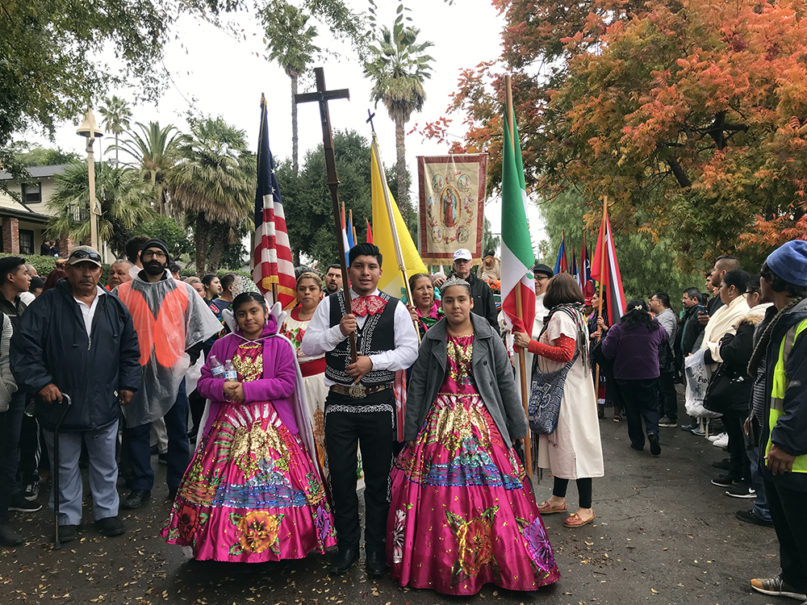(RNS) — To the Very Rev. Esequiel Sanchez, it’s important for Catholics to be cautious, but not afraid, as they prepare to honor the feast of Our Lady of Guadalupe a year after COVID-19 shut down the annual pilgrimage in Des Plaines, Illinois — considered to be the largest gathering in the United States honoring the patron saint of Mexico.
“Fear is the source of much of our pain. We come to offer our fears in prayer to God through Our Lady,” Sanchez said in a news conference Wednesday (Dec. 1), about the upcoming celebration.
The Dec. 12 feast of Our Lady of Guadalupe — typically honored with Masses, pilgrimages and celebrations outside churches — marks the appearance of the brown-skinned virgin to St. Juan Diego, an Indigenous man, on a hill of Tepeyac in Mexico in 1531.
The pandemic last December forced the cancellation of large-scale pilgrimages as the virus surged during the winter months. This year, with more people vaccinated against COVID-19, Catholics across the country are once again gathering to honor the Virgin of Guadalupe, who has been a source of hope for many Latinos throughout the pandemic. As the omicron coronavirus variant circulates, Catholic leaders are urging mask wearing during these events and promoting the vaccine against the virus.
Hundreds of thousands of pilgrims are expected to arrive on foot, bike, bus or car at the Shrine of Our Lady of Guadalupe in Des Plaines to fulfill or make “mandas,” or promises, to the Virgin Mary, praying in return for health, employment and immigration issues. Many make promises to visit the virgin at the Basilica of Our Lady of Guadalupe in Mexico City.
RELATED: As the Feast of Our Lady of Guadalupe approaches, the Virgin Mary inspires community
The two-day celebration at the shrine will begin Dec. 11 with an evening Mass and will follow with fireworks and “Las Mañanitas,” the traditional serenade to Our Lady of Guadalupe just before midnight Mass. On Sunday, there will be a range of prayer services for immigrants and for the elderly and sick, as well as music and folkloric dance performances by choirs, groups, and pilgrims from around the Midwest.
Attendees are to wear masks, and a COVID-19 vaccination site will be located at the weekend gathering, which has normally attracted more than 200,000 devotees. Only Mexico City’s observance of the feast has been thought to be larger.

Dancers wear indigenous attire while performing in honor of the Virgin of Guadalupe in the plaza of the Basilica of Our Lady of Guadalupe in northern Mexico City. The Our Lady of Guadalupe feast day is Dec. 12. RNS photo by Irving Cabrera Torres
Sanchez, rector of the Shrine of Our Lady of Guadalupe, said many of the faithful have been wounded by the pandemic, losing loved ones back home in Mexico and not having the ability to travel there due to immigration status, economic hardship or pandemic concerns. Those who’ve caught the virus fear they can get reinfected and are “unsure of who to trust, who to believe,” Sanchez said.
“The isolation is the biggest factor that I see hurting the community. There aren’t as many resources for mental health for Spanish speakers,” Sanchez told Religion News Service, adding that church and devotion can help address mental health.
The feast day, he said, is more than just a social gathering. “It is a true unburdening. It is a true expression of the community’s soul,” Sanchez said.
In Mexico City this year, the faithful will be able to visit the Basilica of Our Lady of Guadalupe, which closed last year between Dec. 10-13 due to the pandemic. There will be restrictions, however.
Mons. Salvador Martínez Ávila, rector of the Basilica of Our Lady of Guadalupe, in a video on Wednesday (Dec. 1), invited the faithful to “visit with prudence.”
Pilgrims will not be allowed to stay overnight on the grounds of the basilica as in years past, and for the public seeking to visit the basilica to fulfill a promise to the virgin — by, for example, saying a rosary onsite — they’re advised to do so before or after Dec. 11 and 12.
“Keep in mind that many come from afar, and it’s convenient for all of us to not be there at the same time on the same day,” Ávila said.
RELATED: Latino Catholics are among the most vaccinated religious groups. Here’s why.
In Southern California’s Inland Empire, the two main processions — a 34-mile pilgrimage from Palm Springs to Coachella and a 2.5 mile hike up Mount Rubidoux in Riverside County — will once again be canceled. Instead, parishes are advised to host their own celebrations to honor the Virgin Mary.

Hundreds of people hike up Mount Rubidoux, in Riverside, California, as part of a 2.5-mile pilgrimage to celebrate the Virgin Mary on Dec. 7, 2019. RNS photo by Alejandra Molina
Petra Alexander, the Office of Hispanic Affairs director for the Diocese of San Bernardino, said event organizers thought it best to remain cautious during the pandemic. Fundraising for the events was also difficult amid COVID-19 restrictions.
This past year, Alexander said she’s seen people turning to the Virgin of Guadalupe to pray for family to recover from illness. Many have gone to the diocese’s six churches bearing the name of Our Lady of Guadalupe to ask her for protection, she said. She knows of people traveling to Mexico City to thank the virgin for the recovery of loved ones.
The Virgin Mary, Alexander said, helps “soften up sadness.”
In East Los Angeles, the faithful will resume the annual procession on Dec. 5 that, according to the Archdiocese of Los Angeles, was started by Mexican Catholics in Los Angeles, known as “Cristeros,” who fled Mexico due to government persecution in 1931. The pandemic last year was one of the rare occasions in its 90 year history that shut down the procession.
Throughout the years, the Los Angeles procession has included Aztec dancers, Mexican equestrian groups and Guadalupano groups from parishes in the Archdiocese of Los Angeles. The mile-long walk ends at East Los Angeles College Stadium for a Mass presided over by Archbishop José H. Gomez.
Face masks will be enforced regardless of vaccination status.
The Rev. Julio Ramos, president of the Guadalupe Committee, said it was painful and difficult not being able to gather in a normal manner last year to celebrate the Virgin Mary. But, he said, “people understood it was for the greater good.”
This year, there’s a lot of enthusiasm, he said. Ramos, pastor of Our Lady of Guadalupe Parish in the L.A. County city of El Monte, said people are emotionally and spiritually recovering after losing loved ones and seeing family suffering from illness.
To Ramos, Our Lady of Guadalupe carries a message of hope, fraternity and solidarity.
“The Virgin of Guadalupe has inspired many people to serve, to help one another, to have faith in God in difficult moments,” Ramos said.





